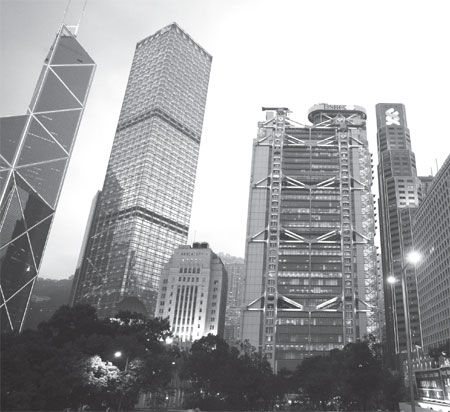Central office rents to fall more
Updated: 2012-07-24 07:21
By Li Tao(HK Edition)
|
|||||||
|
Office buildings stand in Central. Office rents in the business district is expected to see further 5 percent drop in the second half after a 7 percent decline in the first half. Ed Jones / AFP Photo |
Financial institutions eye relocation to save costs amid biz sluggishness
Office rents in Central are under downward pressure, with rates likely to see further 5 percent decline in the second half after falling over 7 percent in the first half, as companies - particularly financial institutions - relocate to save costs amid slowing economic activity and a weak financial market, according to Jones Lang LaSalle.
Decentralization remained a key trend seen in the city in the past six months, with a rise in banking sectors demand for cost-savings through relocation, said Ben Dickinson, head of Hong Kong Markets at Jones Lang LaSalle.
"The uncertainties in the macroeconomic environment will continue to weigh on leasing demand in the second half of 2012," Dickinson commented on the property advisor's mid-year property review for the city on Monday. "Demand from the banking sector is expected to remain weak and tenants will continue to look for cost-saving solutions."
Hong Kong's CBD was the world's most expensive office market, with overall occupancy costs at $248.83 per square foot topping West End's $220.15 per square foot in London, another international property advisor CBRE said in its survey last week.
Despite both offices demand and rental rates continuing to increase in the area, the average East Kowloon office rent remained at only about one quarter of the top rents in Central, noted the survey.
As pressure was largely restricted to the top-tier offices in the prime Central area, rents in the rest of the sub-markets in Hong Kong showed resilience in the first half, with Kowloon East, where Hong Kong government has vowed to invest HK$100 billion to turn the area into the next CBD, registering a 4.7 percent growth.
The vacancy rate of offices in Kowloon East has also scaled down to 5.4 percent in the second quarter from more than 10 percent during the same period last year.
Dickinson estimated that office rents in the area will go up 5 percent further in the following months this year. "While rents in Central may face further correction, we expect those in other submarkets to remain stable," he added.
Jones Lang LaSalle also forecasts a slower growth of retail rents in Hong Kong after it gained an average 7.2 percent in the past six months - the only highlight in the city's overall property sector.
Tom Gaffney, head of Retail from Jones Lang LaSalle, said since retail sales slowed down notably in the second quarter, the city's existing retailers are expected to adopt a more cautious approach towards expansion in the months ahead.
Gaffney, nevertheless, estimates the retail rents to further edge up in the second half this year, albeit at a slower rate, with the leasing demand coming from new market entrants for the limited supply in the major shopping districts.
"Foreign retailers remained keen on Hong Kong, with new brands continuing to set up new operations in the market. In addition, some brands began to expand into decentralized locations, thus narrowing the rental gap between the core and non-core locations," said Gaffney.
The growing inbound tourism, particularly those from the mainland, will also provide strong support to the retail property sector, Jones Lang LaSalle believes.
However, despite that overall tourist arrivals expanded 14.8 percent in the first five months from the same period last year, the number is decelerating on a month-to-month basis.
According to the Hong Kong Tourism Board, visitor arrivals at Hong Kong was merely at 3.64 million last month, down from the 3.84 million and 3.71 million registered in April and March, respectively.
litao@chinadailyhk.com
(HK Edition 07/24/2012 page2)
